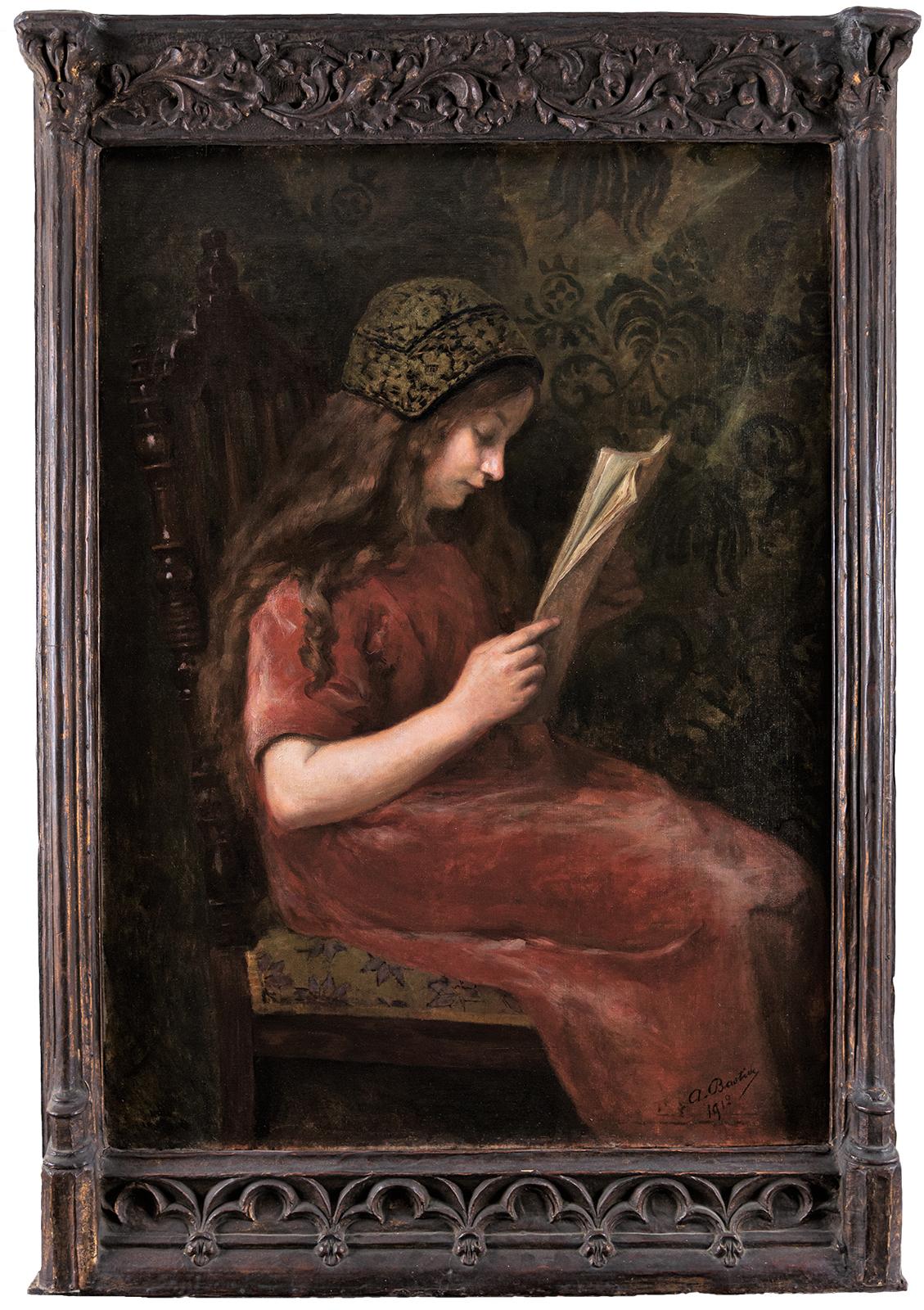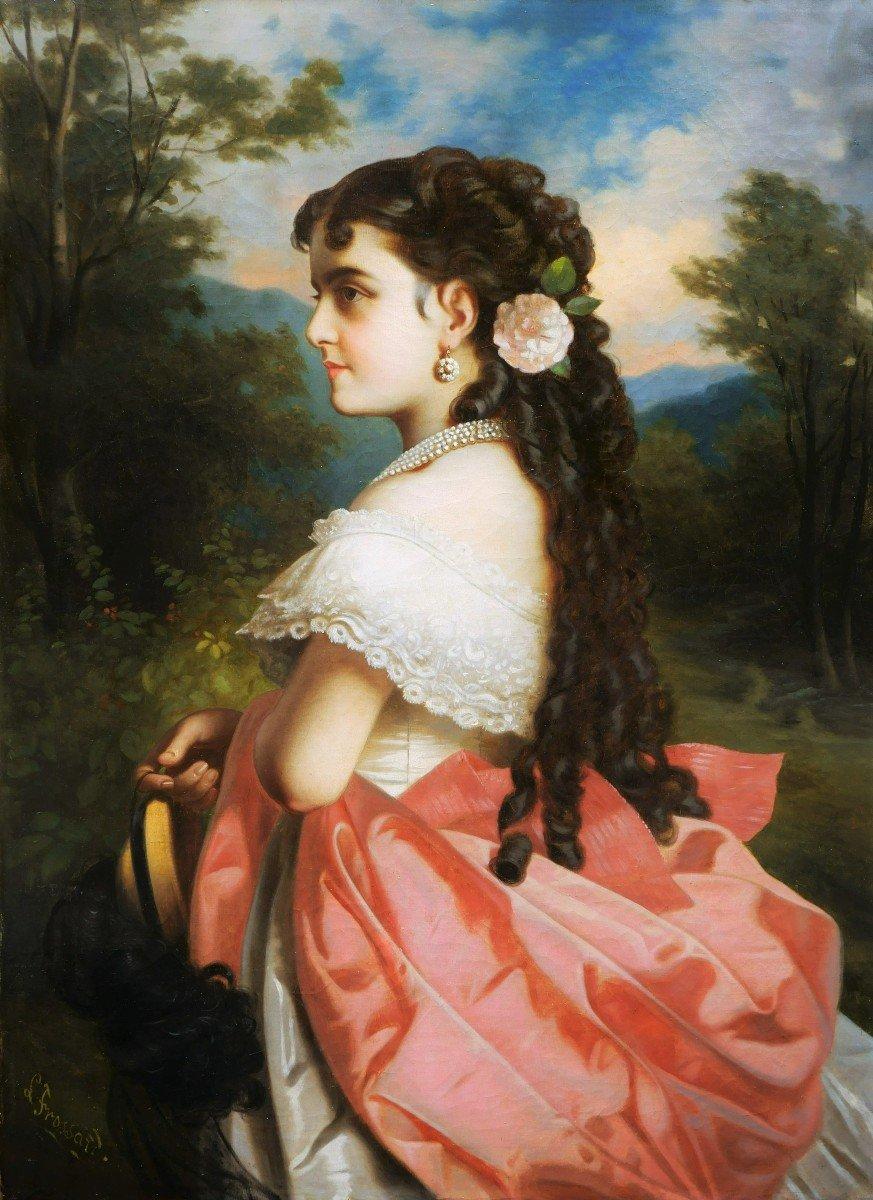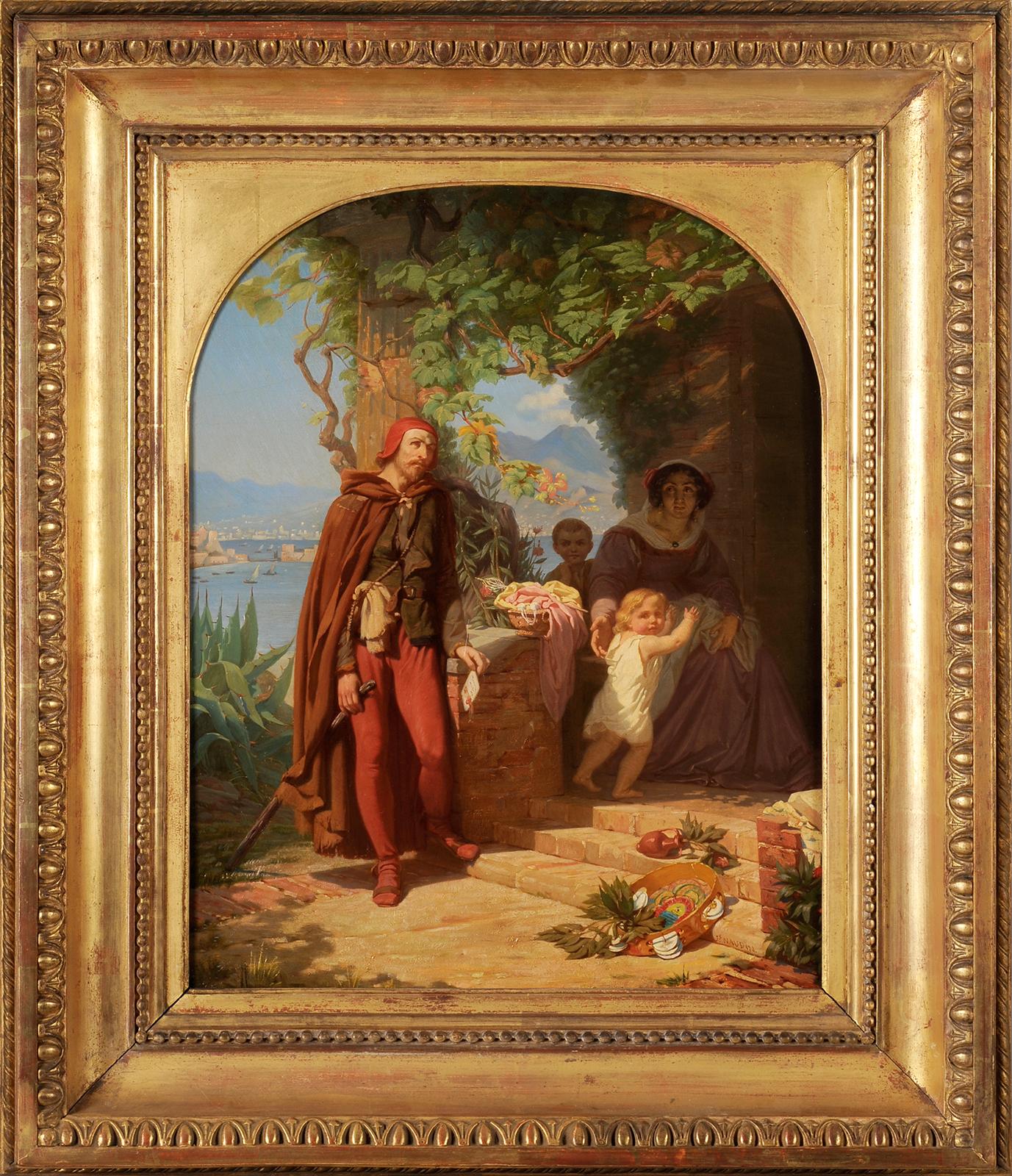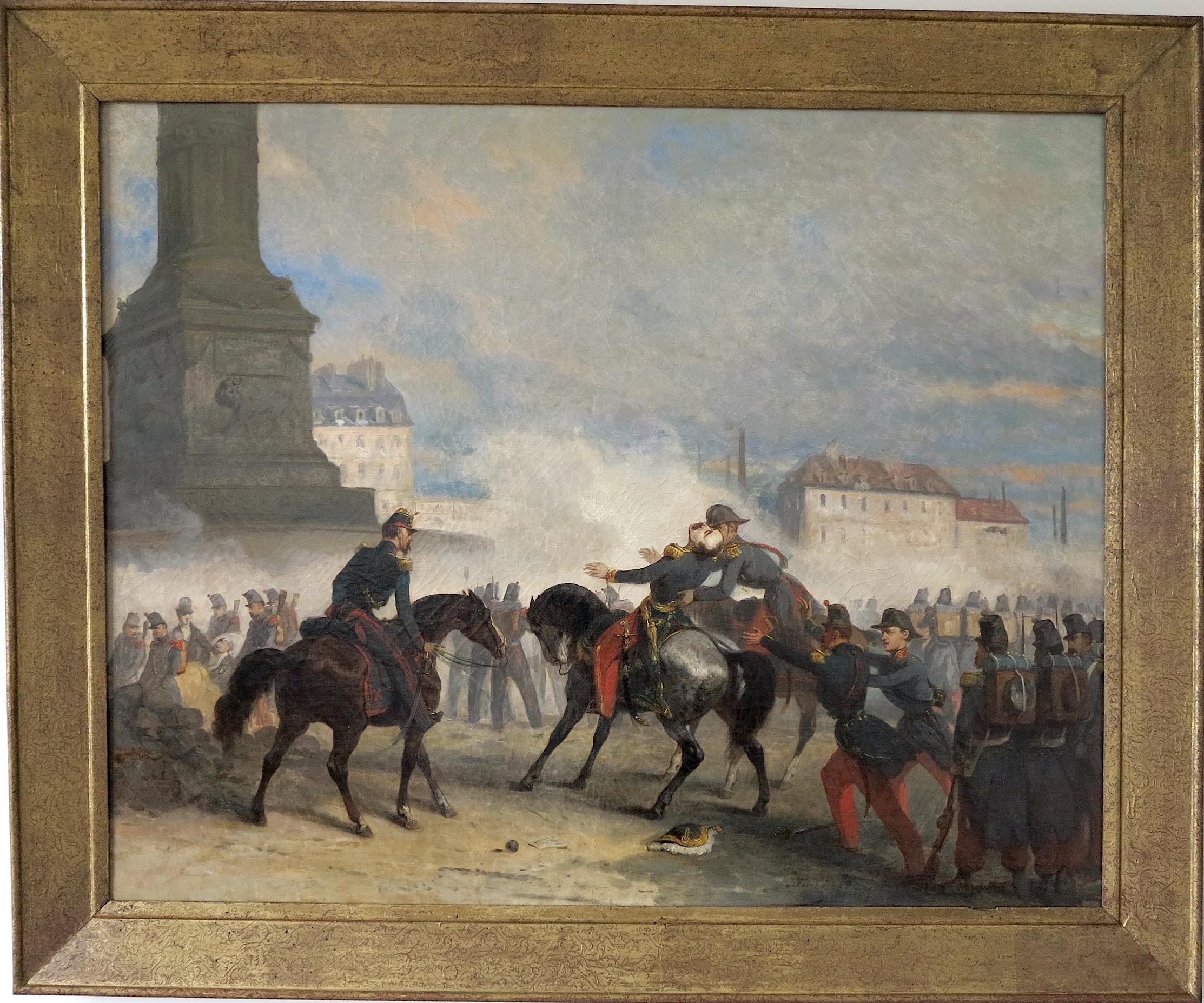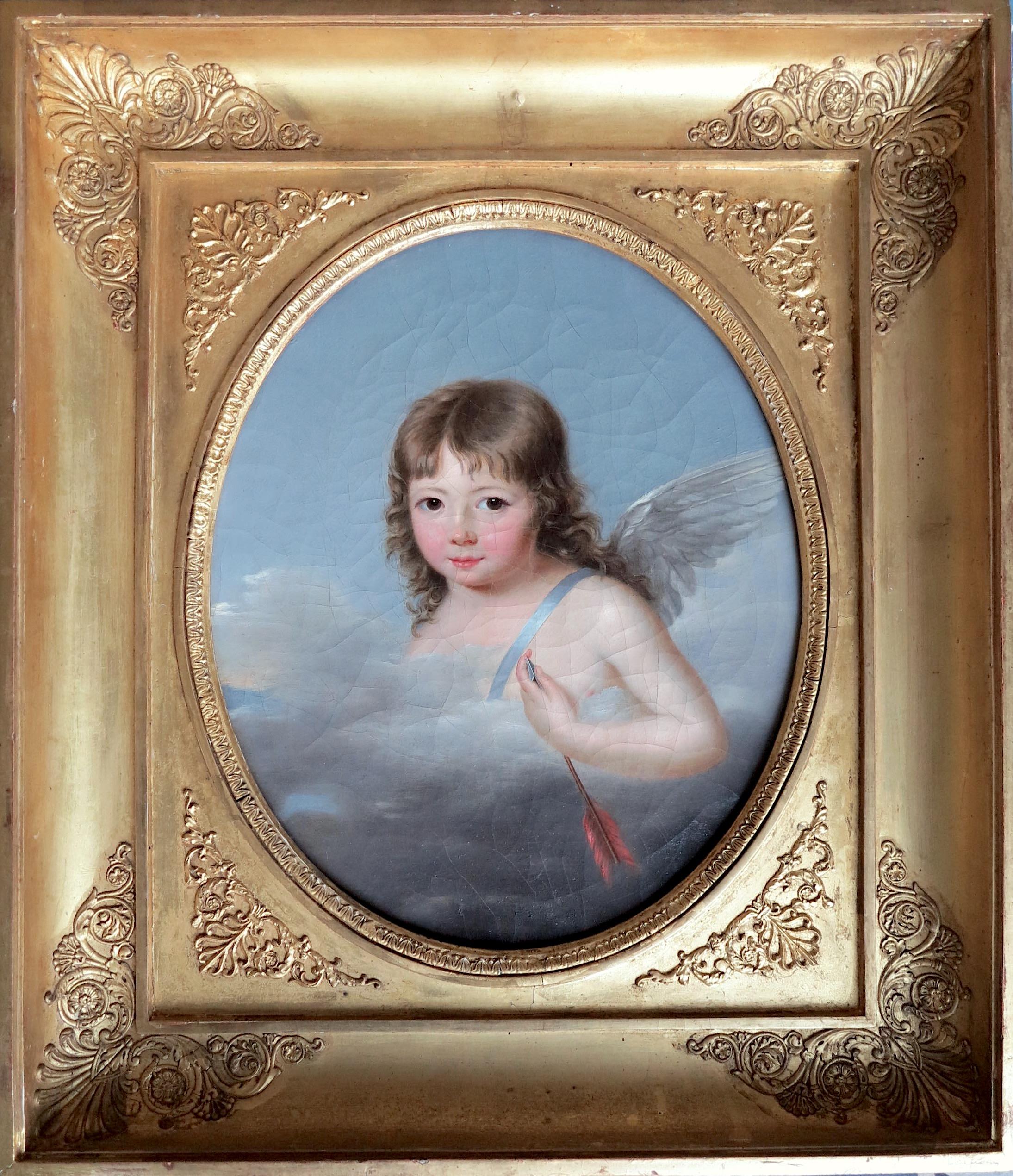Items Similar to The Beautiful Maiden
Want more images or videos?
Request additional images or videos from the seller
1 of 10
Jan Van BeersThe Beautiful Maiden1875
1875
About the Item
Jean Marie Constantin Joseph (Jan) VAN BEERS
Oil on Panel
Panel Size: 32 x 24" (81 x 62cm)
Outside frame Size: 38 x 33" (97 x 83cm)
Van Beers (1852 - 1927) studied at the Royal Academy of Fine Arts in Antwerp. Soon afterwards, he became the leader of a group of young artists, the "Van Beers clique." This group included the artists Piet Verhaert (1852–1908), Alexander Struys (1852–1941), and Jef Lambeaux (1852–1908). They were well known for their mischievous and eccentric behaviour, including walking around Antwerp dressed in historic costumes. These eccentricities aside, several art critics had been emphasizing the technical skills of Van Beers, comparing them to those of the Old Masters. In 1878 Van Beers moved to Paris, and he started to work in the studio of his fellow Belgian painter Alfred Stevens.
In Paris he immediately abandoned historical pictures, producing instead genre and portrait works of the middle classes and developing a successful line in attractive draped young ladies reading a letter or a book or day-dreaming about a lover. His subjects were painted in a highly-finished Naturalist style. He painted very small pictures, delicately brushed, hyper-realistic in their details and extreme finish. Success was almost immediate.
However, at the Brussels Salon of 1881, Van Beers found himself amid a scandal that would upset the Belgian art world and, at the same time, give him instant recognition. He exhibited two paintings at the Brussels Salon of that year, both painted in his new, miniature-like and hyperrealistic style. One of the works, The yacht 'Sirene,' was to become the subject of the turmoil. He was accused to have pushed his realistic style beyond the boundaries of the possible. The Belgian critics Solvay and De Mons suspected him to have painted over a photograph, calling his work a photo-peinture. While the Review L' Art Moderne defended him by suggesting that those were merely echoing comments of some artists who were jealous of Van Beers' commercial success, the scandal nonetheless raised considerable attention.
Van Beers decided to react promptly. He offered to have both his paintings scraped off and checked by experts . If they could discover even the most remote trace of the use of photography, Van Beers would pay them 10 000 francs for Lily, his second exhibition piece, and 20 000 francs for La Sirene, the prices he was asking for them. On the other hand, if they couldn't find anything, the critics were to pay this amount to the Caisse de recours (a pension fund) of the Brussels artists.
The critics refused the challenge, arguing that Van Beers just had to recognize his mistake. Then, on September 3, 1881, during the short absence of the guards at the Salon, an unknown person vandalized the Sirene by scratching off the face of the young woman. Immediately the painting attracted even more attention and crowds of visitors, who wanted to check by themselves if any trace of photography was visible. Van Beers took this opportunity to name a commission to examine the painting. It included the president of the Cercle Artistique et Littéraire of Brussels, the artists Charles Verlat and J.F. Portaels, and two specialists in photography and chemistry. After a thorough examination the commission's report cleared Van Beers of all charges and concluded that he was "an honest man." L'affaire Van Beers" gave him Europe-wide attention. Previously a largely unknown artist, Van Beers was able to use his newfound fame to sell his work for large sums.
Van Beers said that he wanted to paint what he saw and what were the best and most interesting things that one saw in Paris. He explained in an 1893 interview for the Westminster Budget that "all my pictures are from models, and I know where to find them whenever I want them. It requires a good deal of diplomacy to get them to pose. One has to pet and coax them, and even then they often leave you in the lurch."
Vanity Fair showed him with a typical subject in their 1891 caricature titled "The Modern Wiertz" (Antoine Wiertz, 1806–65).
Museum and Gallery Holdings
Amsterdam: Funeral of Charles the Good
Antwerp (Koninklijk Mus. voor Schone Kunsten): Peter Benoit, Director of the Flemish Conservatory in Antwerp (1883, oil on panel); The Painter’s Parents (oil on canvas); Lady in White (oil on panel); Fallen Star (1874, oil on canvas); Henri Rochefort (oil on panel); Jacob van Maerlant on His Deathbed (1879, oil on panel); Maerlant Presiding over the Liberation of Flanders from Breydel and Corninck; William of Jülich; Saeftingen; Emperor Karel as a Child (1879, oil on canvas, triptych)
Boston (MFA): Portrait of a Man (oil on panel)
Brighton (Mus. and AG): Lady of the Directoire (1889, oil on panel)
Brussels (Mus. Royaux des Beaux-Arts): Portrait of Sarah Bernhardt (1888, oil on panel)
Madrid: Peasant Woman from the Ambères Region Milking a Cow
Rouen: Parisian Woman
Washington DC (Nat. Portrait Gal.): Charles Tyson Yerkes (oil on panel)
- Creator:Jan Van Beers (1852 - 1927, Belgian)
- Creation Year:1875
- Dimensions:Height: 38 in (96.52 cm)Width: 33 in (83.82 cm)Depth: 3 in (7.62 cm)
- Medium:
- Movement & Style:
- Period:
- Condition:Oil on Panel. It has the artist's label on the reverse. it is in the original frame.
- Gallery Location:St. Albans, GB
- Reference Number:1stDibs: LU2469212863602
About the Seller
5.0
Gold Seller
These expertly vetted sellers are highly rated and consistently exceed customer expectations.
Established in 1965
1stDibs seller since 2023
19 sales on 1stDibs
Typical response time: 2 hours
- ShippingRetrieving quote...Ships From: St. Albans, United Kingdom
- Return PolicyA return for this item may be initiated within 7 days of delivery.
More From This SellerView All
- A Spanish LadyBy Charles BaxterLocated in St. Albans, GBA perfect example of Charles Baxter's work. A beautiful Spanish lady wearing typical Spanish attire. Despite being unsigned, the painting has full provenance having being fully catal...Category
Late 19th Century Victorian Figurative Paintings
MaterialsOil
- A Pre-Raphaelite BeautyLocated in St. Albans, GBA wonderful painting of a beautiful woman in the style of the Pre-Raphaelites. It is signed Arnhold. It is in very condition and in the original frame. Picture Size: 21 x 21" (51 ...Category
1850s Pre-Raphaelite Portrait Paintings
MaterialsOil
- The Rose SellerLocated in St. Albans, GBAlfred Edward Emslie A beautiful example of Arthur Emslie's work combining his renown ability for portraiture and genre. The soft tones of the background and dress contrasted with the highlights in the face and the large, vibrant bouquet of roses creates a piece perfect for any situation. It is a painting showing class, technique and subtlety. Provenance: Bonhams Canvas Size: 22 x 18" (56 x 46cm) Outside Frame Size: 32 x 28" (81 x 71cm) 1848-1918 Alfred Edward Emslie was an English genre and portrait painter and photographer. He was the son of the engraver, John Emslie...Category
1890s Victorian Portrait Paintings
MaterialsOil
- Before the ballBy Charles BaxterLocated in St. Albans, GBA perfect example of Charles Baxter's work. Two beautiful ladies , one holding a flower, dressed in their best finery. Despite being unsigned, the paint...Category
Late 19th Century Victorian Figurative Paintings
MaterialsOil
- The RoseLocated in St. Albans, GB'The Rose' Canvas Size: 38.5 x 28" (98 x 71cm) Outside Frame Size: 48.5 x 38 (123 x 97cm) Oil on canvas Emile CHARLET 1851 - 1890 Born 1851 in Belg...Category
1870s Impressionist Figurative Paintings
MaterialsOil
- Portrait of a Lady possibly Frances Thynne, Lady Worsley 1673-1750 Oil on canvasBy Charles JervasLocated in St. Albans, GBCharles Jervas Possibly Frances Thynne, Lady Worsley 1673-1750 Oil on Canvas Picture Size: 50 x 40" Outside Frame Size: 58 x 48" 1675 – 1739 Charles Jervas, who was born in Clonli...Category
Early 1700s English School Portrait Paintings
MaterialsOil
You May Also Like
- Young girl readingLocated in BELEYMAS, FRAlice BASTIDE (Saint Mandé 1868 – Paris 1959) Portrait of a little girl reading Oil on canvas H. 100 cm; L. 72.5 cm Signed lower right and dated 1912 Daughter of a pastor from Gard and an English woman, Alice Bastide grew up in Paris. A pupil of the Jullian Academy, she began her apprenticeship under the guidance of Henri Royer and François Schommer. The development of his art is mainly oriented towards still lifes, without completely abandoning portraits and landscapes. Her other specialty for which she received numerous awards is miniatures. At the Salon of 1914 she received the Maxime David prize crowning the best piece while her finesse was already noticed by press critics from 1907. Coronation, in 1926 she received a gold medal at the Salon for her miniature Coquetterie. In 1896, the young woman married a man from Gard, Auguste Massebiaux, whose name she would occasionally bear. The latter, a lawyer at the Paris Court of Appeal, died in 1910. The couple had no children. At that time she was domiciled at 48 avenue d'Orléans (later named avenue du general Leclerc) in Paris where she lived until her death in 1959. Until the mid-1930s she continued to exhibit at the Salon des Artistes French with a manner very close to Impressionism, luminous and vigorous. In 1912, two years after the death of her husband, Alice Bastide was certainly still marked by the sadness of her mourning. The tones of our portrait of a little girl and the frame she puts together are dark and heavy. This child, wearing an embroidered bonnet, is bent over her book, her loose hair flowing over a red velvet indoor dress. This intimate portrait on a dark tapestry...Category
1910s French School Figurative Paintings
MaterialsOil, Canvas
- Portrait of singer Adelina Patti - L. Frossard - OperaLocated in BELEYMAS, FRL. FROSSARD (active in Vienna around 1870) Portrait of Adelina Patti (1843-1919) Oil on canvas H. 100.5 cm; L. 73.5 c Signed lower left If the artist maintains a certain discretion ...Category
1860s French School Figurative Paintings
MaterialsCanvas, Oil
- Jules Naudin (1817-c.1876) - Tasso arriving at his sister's house in SorrentoBy Attilio ManganaroLocated in BELEYMAS, FRJules Ambroise Francois NAUDIN (Paris 1817 – c.1876) Tasso arriving at his sister's house in Sorrento Oil on canvas H. 49 cm; L. 37.5 cm Signed lower right Exhibition: 1852, Paris Salon, under number 959 Related work: Engraving by Jean-Denis Nargeot in 1852 Bibliography: L’Illustration, April 24, 1852, engraved by Best, Hottelin and Regnier, after a drawing by Valentin) and reproduced p.260, cited p.262; La Mode: Political, Religious and Literary Review, 1852, quoted; Journal des Demoiselles...Category
1850s French School Figurative Paintings
MaterialsCanvas, Oil
- The death of General Négrier on Place de la Bastille, Paris - FranceBy Nicolas Edward GabéLocated in PARIS, FRNicolas Edward GABE (Paris, 1814 - Paris, 1865) The death of General Négrier on Place de la Bastille on June 25, 1848 Oil on canvas Signed and dated lower right 82 x 101 cm 1849 Nicolas Edward Gabé is a 19th century artist who is still little studied to this day and yet seems to have enjoyed, according to the artistic press of the time, a certain notoriety, in particular for his seascapes. The few bibliographical elements that we have come from the Salon booklets and tell us that the artist was born in Paris in 1814, therefore shortly before the end of the Empire. No elements on his artistic training are mentioned in the booklets, we just know that Gabé exhibited at the Paris Salon from 1835 to 1864 where he first practiced miniature then then approached easel painting, risking himself as well in still life that the seascapes, the landscape, the portrait or the hunting. According to press articles, he also took part in various exhibitions in the provinces such as Boulogne-sur-Mer and Marseille. Notably, Gabé did not exhibit at the Salon his large historical canvases on the revolution of 1848, which today are of obvious documentary and iconographic interest; probably for political reasons which are easily understandable to us today in view of the historical events of then. Gabé died in Paris at the age of 51 on January 4, 1865 with a mention in the January 7, 1865 edition of L'Union des Arts: “The death of Mr. Gabé, painter, well known in the export trade in paintings as well as to the auctioneers' hotel, whose sales it supplied through its numerous navies. “ "On June 25, 1848, in front of the barricades erected in the Bastille by the insurgents of the Red Republic, General Négrier fell to death, while he was uttering words of order and conciliation". Here are the opening lines of the tribute paid by Colonel Borgarelli d´Ison, friend of General Négrier. General Négrier belonged to a family from Maine, brought back by Marshal Lannes from emigration. Born in Le Mans on April 27, 1788, François Marie Casimir de Négrier entered, barely 18, as a volunteer in the 2nd Light Infantry Regiment. He began in 1806 with the campaigns of Prussia and Poland, during which he earned, through his bravery, the rank of sergeant and the decoration of the Legion of Honor. He made the following campaigns in Spain and Portugal, and left, with his regiment, only for the campaign of France, in 1814, after having risen successively, by actions of brilliance and by a serious wound, to the ranks of head of battalion and officer of the Legion of Honor, with which he was provided from October 1813. The Restoration retained his rank in his regiment. After having fought and wounded a second time seriously in Waterloo, Négrier was recalled in 1816 under the second Restoration. He was appointed, in 1825, lieutenant-colonel, then colonel in 1830, brigadier general in 1836, and of division in 1841. From March 1837 he participated in the conquest of Algeria. The Revolution of 1848 found Negrier in possession of the important command of the 16th Military Division in Lille. Quaestor of the Assembly in these times which promised to be troubled, Négrier reviewed the Place de la Concorde on June 23 at around noon various mobile guard battalions. He then took the head of 2,000 men provided by the 10th and 11th legions of the national guard and bivouacked on the Place du Palais until the next day 24. On Sunday 25 at nine o'clock, the Négrier division resumed the fight towards the Saint suburb. -Antoine. The troop gains continual advantages. At around two o'clock the column of Négrier had seized the Pont Marie: it had removed the barricades from the Quai Saint-Paul, the rue de l'Etoile, the rue des Barres...Category
Mid-19th Century French School Figurative Paintings
MaterialsOil
- CupidBy François Pascal Simon GérardLocated in PARIS, FRFrench School of the early 19th century Circle of Baron GERARD (1770-1835) or Circle of Élisabeth Louise VIGÉE-LEBRUN (Paris, 1755 – Paris, 1842) Cupid ...Category
Early 19th Century French School Portrait Paintings
MaterialsOil
- Study of a Breton shepherdessBy Theodore ValerioLocated in PARIS, FRThéodore VALERIO (Herserange, 1819 – Vichy, 1879) Study of a Breton shepherdess Oil on canvas mounted on cardboard Bears the sale stamp at the bottom 31 x 22 cm Provenance: Sale o...Category
Late 19th Century French School Figurative Paintings
MaterialsOil
